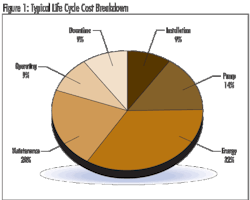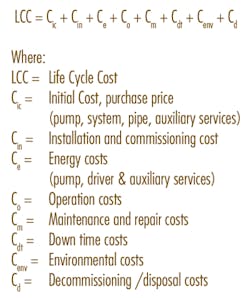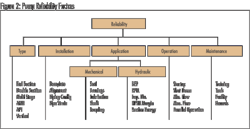Key Considerations for Pump Life Cycle Cost Reduction
By Allan R. Budris
In the writer's first (August 2007) WaterWorld Pump Tips Column it was pointed out that there are certain basic traits that distinguish the best-of-class from the retroactive-fix-up pump users, whose associated pump costs are normally much higher. One such key trait is that best-of-class users do not purchase pumps based mainly on the lowest initial cost, but instead consider the total life cycle cost of the pump installation, which could be 20 times the initial pump cost.
The primary objective of life cycle costing is to evaluate and/or optimize product life cost while satisfying specified performance, safety, reliability, maintainability, and other requirements.
Pumping systems account for 25-50% of the energy usage in many industrial plants, and 20% of the world's electric energy demand. Centrifugal pumps rank first in failure incidents and maintenance costs. That is why centrifugal pumps in critical applications are often installed in identical pairs, with one serving as the operating and the other serving as the standby or spare pump.
Despite these statistics, many pumps are still purchased based solely on the lowest initial purchase and installation cost. These decisions seem to disregard the fact that the initial cost is only a small part of the pump life cycle cost in high usage applications. Market conditions, short-term financial considerations, and organizational barriers are to blame for this short sighted environment.
Progressive, reliability-focused pump users who seek to improve the profitability of their operations should, therefore, consider using Life Cycle Costing, or LCC. The conscientious application of LCC concepts will help plants minimize waste. LCC will also dramatically reduce energy, operation and maintenance costs.
Life cycle pump cost is the total lifetime cost to: purchase, install, operate, and maintain (including associated downtime) the pump and associated support equipment, plus any environmental cost due to contamination from pumped liquid, and the disposal/decommissioning cost of a piece of equipment.
Figure 1: Typical Life Cycle Cost Breakdown
A simplified mathematical expression for life cycle cost is:
Energy, maintenance and down time costs depend on the selection and design of the pump, the system design and integration with the pump, the design of the installation, and the way the system is operated. Carefully matching the pump with the system can ensure the lowest energy and maintenance costs, and maximum equipment life.
When used as a comparison tool between possible design and/or overhaul alternatives, the Life Cycle Cost process will show the most cost effective solution, within the limits of the available data. Figure 1 shows one typical breakdown of life cycle costs. In this case, the initial pump purchase cost represents only 14% of the total life cycle cost. References 1 and 2 offer more details on the Life Cycle Cost analysis.
Initial Costs
The initial investment costs include the initial pump and pumping system costs. Initial costs also include engineering, bid process ("bid conditioning"), purchase order administration, testing, inspection, spare part inventory, training and auxiliary equipment. The purchase price of the pumping equipment is typically less than 15% of the total ownership cost. The initial cost is dependent on such critical factors as the size and design of the pump piping, pump speed, the quality / duty rating of the equipment being selected, materials of construction and control system. All of these choices can substantially affect the life cycle cost and working life of the pump.
Installation Costs
Pump installation and commissioning costs include the foundations, grouting, connecting of process piping, connecting electrical wiring, connecting auxiliary systems, equipment alignment, flushing of piping and performance evaluation at start up. The care and effectiveness in executing these installation activities will have a great impact on subsequent reliability, maintenance and down time costs during the life cycle of the pump. Unless shown to be outdated, the equipment manufacturer's installation, start-up and operation instructions should be adhered to. A checklist should be used to ensure that the pump, support equipment and the system are operated within specified parameters.
Figure 2: Pump Reliability Factors
Energy / Operating Costs
Pump / System Energy consumption is often one of the larger cost elements and may dominate the total Life Cycle costs, especially if a pump operates more than 2000 hours per year. Energy and maintenance costs incurred during the life of a pump system usually account for more than 10 times the purchase price. Energy costs are dependent not only on the best efficiency of the pump(s), but also on the energy consumed by the pump system (pipe size, etc.), and by how much time and how far the pump spends operating away from the best efficiency flow rate. Additional influencing factors include the type of pump control, including minimum flow bypasses, control valve pressure break down, any variable speed operation, plus auxiliary service energy consumption, and driver selection and application.
Operating costs are labor costs related to the operation of a pumping system. These vary widely depending on the complexity and duty of the system. Regular observation of how a pumping system is functioning can alert operators to potential losses in system performance. Performance indicators include changes in vibration, shock pulse signature, temperature, noise, power consumption, flow rates and pressure.
Maintenance and Repair Costs
Obtaining optimum working life from a pump requires special care in the design of the system (pump piping, etc.), design and selection of the pump, controls, installation, and regular and efficient servicing. The cost depends on the time and frequency of service and cost of materials. Pump design can greatly influence these costs through the hydraulic selection, materials of construction, components chosen, and the ease of access to the parts to be serviced.
Down time can be minimized by preventive maintenance programs, and conducting major maintenance during annual shut-down or process change-over. Although unexpected failures cannot be predicted precisely, they can be estimated statistically by calculating mean time between failures, or possibly avoided through continuous monitoring with fault tolerant smart pump control systems.
Loss of Production
The cost of unexpected downtime and lost production can be a very significant item in total life cycle cost, and can rival the energy costs and replacement parts costs. All of the above factors affecting the working life of a pump can impact down time and loss of production. Despite the design or target life of a pump and its components, there will be occasions when an unexpected failure occurs. In the cases where the cost of lost production is unacceptable, a spare pump may be installed in parallel to reduce risk. If a spare pump is used, the initial cost will be greater, but the cost of lost production will be avoided, or at least minimized.
Life Cycle Factor Summary
Finally, Figure 2 summarizes the many life cycle factors that influence pump reliability (and operating) costs. These obviously include selection (type of pump chosen), installation, usage (application), operation, and maintenance-related parameters. Many of these factors have been covered in other past Pump Tips Columns. WW
Reference: "Pump User's Handbook, Life Extension" by Heinz P. Bloch & Allan R. Budris, second edition, 2006, by Fairmont Press, Inc.
"Pump Life Cycle Costs: A Guide to LCC analysis for Pumping Systems", Hydraulic Institute, Europump and U.S. Department of Energy, ISBN 1-880952-58-0, 2001
More WaterWorld Current Issue Articles
More WaterWorld Archives Issue Articles




